You’ve heard about the power of the ultraviolet spectrum, but should you trust your fish tank with it?

Are you familiar with the basics – did you know that a submersible UV sterilizer with its own pump powerhead would work best for your aquarium?
I mean, if you already have a strong flow rate on your filter, why would you want additional turbulence to your water, right?
Another thing I need to share with you is that the size of your tank affects the power of the UV bulb. That being said, I will show you what’s an adequate choice for a larger tank or a small nano one.
But would the UV light from the bulb interfere with fertilizers in a planted aquarium and coral food in a reef tank? How about your setup – does that matter too? Is there a difference between an aquarium UV sterilizer for freshwater and saltwater fish tanks or are the units one and the same?
I’m taking the liberty to help you make the competent choice, by clarifying these questions, along with your water.
If you want to jump right at my experience with the products I recommend taking look at this overview chart that compares each entry on my list:
| UV Sterilizer Name: | Recommended for: | For Aquarium of: |
|---|---|---|
| 1. AA Green Killing Machine UV | Clearing up green water and persistent bacterial blooms | 5, 10, 20, 30, 40, 55, 125, 150, and 180 Gallons |
| 2. Turbo-Twist Aquarium UV Sterilizer | Clearing up green or cloudy aquarium water; Long-term pathogen control in freshwater systems | 55, 75, 90, 125, 150, 180, and up to 200 gallons |
| 3. AQUA UV Advantage 2000+ | Clears up green or foggy aquarium water | 55 to 90 Gallons |
| 4. Jebao PU-36 Aquarium and Pond UV Clarifier | Water sterilization and control of parasitic outbreaks in freshwater fish tanks and ponds | From 55 to 200+ Gallons and larger ponds |
| 5. COODIA | works best in the smaller tanks | 20, 30, 40 Gallons |
A buyer’s guide to UV sterilizers and their role in a home aquarium
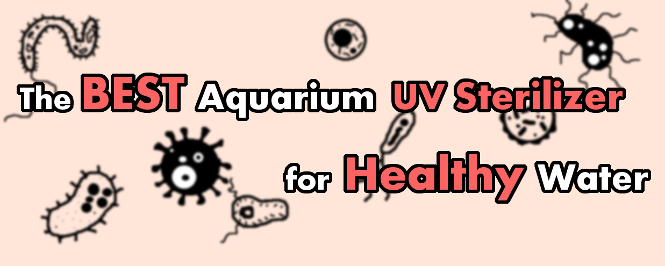
Let me bust some myths and explain the truth surrounding these controversial aquarium devices.
Basically, a UV sterilizer is a tube with an ultraviolet bulb through which aquarium water passes and spins around the bulb. The UV light from the bulb irradiates microorganisms in the water and kills or prevents them from multiplying.
1. What does it do in the fish tank and what to expect from it
Many water facilities are already using ultraviolet light as a means for sterilization of drinking water. However, it’s a common misconception circulating the Internet that UV light kills waterborne organisms in the aquarium.
That’s plain wrong.
The ultraviolet spectrum is carcinogenic. The benefits of running a UV sterilizer are rather collateral. It’s precisely this feature that fish keepers are employing when installing one such unit:
When passing through the tube the aquatic pathogens and parasites will not be directly killed.
The UV bulb will actually bombard their genetic code with high-energy particles, effectively causing mutations, and giving them cancer.
From there on they will be unable to reproduce with each other and therefore they will lose numbers in the water column of your aquarium or pond.
The most effective wavelength of ultraviolet light is in the interval between 240 and 280 nanometers. This wavelength is known as germicidal. This means that light at such wavelengths kills most known bacteria or other pathogens.
The UV filters that I’ve chosen in this article all use the germicidal wavelength. This makes them very effective at clearing your aquarium’s water from vermin.
2. It won’t make the aquarium water completely sterile
It would be an overstatement to say that a UV sterilizer will render your aquarium water completely free of vermin.
Studies have found that at any time there is a number of living microorganisms in a fish tank.
It’s overstocked with all kinds of micro-fauna, way higher in numbers than if it were in the wild waters. This includes good AND bad microscopic life.
What may cause a “crash” or an outbreak is the imbalance in these numbers, favoring the harmful organisms.
The UV lamp in your new UV sterilizer will effectively reduce said numbers and it will prevent a possible outbreak of a variety of parasitic creatures. The reduced population density of the vermin allows the immune systems of fish to handle threats on time, encouraging them to develop more antibodies in the process.
Following these thoughts, a UV sterilizer is not something you should keep constantly on in your aquarium. I use mine as a means of maintenance most of the time.
Once you’ve dealt with whatever nuisance in the water of your fish tank it’s smooth sailing from then on.
- A UV sterilizer can’t treat a parasitic infection in fish that has already started. It will only reduce the population of parasites in the water column, but it won’t take care of the ones that are already in or on your fish.
- A UV sterilizer will never make your water completely sterile. This includes both beneficial and harmful organisms. It will only bring in the needed stability for a safe aquarium water.
This means that if you have a green water problem in your aquarium, getting a UV sterilizer is your best bet. It will make the free-floating microalgae spores unable to multiply further and they will eventually die out.
But if you have an Ich outbreak that has already established itself, then you’d still need to treat your fish with the needed medication, apart from just the water.
After the Ich infection has been treated the infant parasites will subside in the substrate.
However, upon maturity, they will leave the substrate and become free-swimming, in search of a host. This is when the UV sterilizing system comes into play, killing any mature-stage ich parasites, called Theronts.
Another scenario is if you have algae that are already growing on decor and other plants and not microalgae. The UV sterilizer won’t be of help with that.
In that case, you should first eradicate the algae through other proven methods and then run the sterilizer to kill off any free-floating spores.
So if your fish tank suffers from cloudy water thanks to a severe bacterial bloom then getting a water sterilization unit will make sense.
In fact, that’s one of the most efficient tools to treat these conditions.
However, if the water haziness is present due to microbubbles or debris you can’t rely on the UV lamp to clear it. In that case, you need some sort of fine mechanical filtration such as polyfill filter floss. These sorts of filter media are very good at trapping physical particles and debris and filtering them out of your tank.
For me, it all changed when I got my first UV sterilizing system.
Though I was skeptical at first, it turned into a must-have for many of my tanks.
Ever since that one purchase, I haven’t really experienced any nasty diseases in my fish tanks.
I got a separate unit for all of my tanks, eventually.
It’s really liberating not having to worry if I’ll crash my whole tank every time I’m introducing new fish or other livestock to it. Quarantine tanks are a reasonable option for keeping an eye on new fish, but that’s a whole other setup to take care of.
Many of use don’t have the means and space to set up a separate tank just for that reason.
3. Consider the size of your fish tank
This may seem kind of obvious, but I must say it.
For a UV sterilizer to perform well you’d need to match its power with your aquarium’s size and gallon capacity.
If you get a weaker unit, it will need a lot more time to fully disinfect the water in your larger tank. Moreover, if the UV sterilizer doesn’t filter water fast enough, this could give sufficient time for the free-floating spores to multiply and maintain their numbers.
Manufacturers know this, so they rate their products according to how big of an aquarium they should be used on.
These ratings do not always match reality.
There are different suggestions on this matter online and they greatly vary.
I remember reading somewhere that you’d need a 25 W bulb for clearing up microalgae blooms in a 55-gallon tank…
That’s overkill.
I can only assume these people have never used a 13W bulb on a 75-gallon tank.
However, if you’re after pathogenic control in a 55-gallon aquarium (prevention of Ich, Velvet, etc), then a 25 Watt bulb may make sense.
Anyway, if you get the right Wattage on a UV sterilizer, you can expect the unit to fully clear the aquarium’s water in 4 to 6 days.
And that’s in the most severe cases.
Getting a stronger UV lamp will net you faster results, but you’ll pay more money upfront.
Weaker UV filters will just take longer to clear up the water, to a point where it becomes ineffective because the microorganisms multiply faster than the lamp can handle.
For this reason, I put together my personal recommendations for each aquarium size.
In that section of my guide, I speak of personal experience and my work with clients. I’ve had the opportunity to witness hundreds of aquariums and monitor them over time. This, and other people’s reports is what I’ve based m recommendations on.
4. Submersible VS. Non-submersible
Generally speaking, there are two types of UltraViolet sterilizing systems – submersible and non-submersible ones. Each type has its advantages and disadvantages:
A submersible unit is considered safer as if there’s a leak, the water won’t end on your room’s floor.
However, a UV unit can be bulky and unsightly inside the aquarium.
Many fish keepers are quite picky about the inner aesthetics of their tank, so this may play a role in their final choice.
In my opinion, it is not a big deal, as UV sterilizers (contrary to popular belief) should not be on constantly.
If you get a submersible one, you can simply take it out of the aquarium when it’s not running.
Overall, for people that own many tanks, the best UV sterilizers are the submersible ones, because of their mobility.
5. With or Without a Pump
Another thing to consider is if you’d want your sterilizer to come with its own powerhead or if it will be dependent on your filter’s flow rate.
See, for the water to be irradiated by the UV bulb it needs to pass through the tube where the bulb sits. Something needs to force water through the tube and that something is either a built-in powerhead in the unit itself or you link the UV tube to your filter.
I highly recommend that you go for a UV sterilizer that has its own pump and here’s a solid reason for that:
When there’s a separate pump, the flow rate is as per the manufacturer’s instructions. This is very important for the types of pathogens the UV water filter will be targeting.
If there’s no powerhead the speed at which your UV sterilizer works is dependent on your filter’s water turnover.
Learn more about that in the next section.
6. Flowrate and dwell time
The performance of your UV sterilizer depends on the dwell time of the microorganisms. The dwell-time is defined by:
- The flow rate of the pump that forces water into the tube;
- The size of the tube and the UV bulb;
- The Wattage power of the UV bulb.
Generally, it goes like this:
At a slower flow rate, the pathogens are exposed for a longer time to UV light. This reduces the number of parasites, and more resilient bacteria and microbes.
At a higher flow rate, there’s less time for the organisms to be exposed to the bulb’s destructive radiation. Such flow rates are recommended when you’re dealing with the green aquarium water syndrome. Microalgae spores are not as resilient and they can still be eradicated with a higher GPH (Gallons per hour) turnover.
As you can see, control is everything here.
Usually, in larger aquariums, the need for filtration is greater, because they’re housing larger, messier fish.
The common practice is to employ canister filters, as they provide higher flow rates, among other advantages over Hang-On-Back filters.
In such systems, it’s normal (and healthy) to have the water turnover at 6 to 8 times per hour, which often equals more than 600 GPH.
This turnover, however, would often be too much for a UV sterilizer to do its job, unless the bulb is really strong.
A very strong bulb shortens the dwell time needed for parasites to get seriously damaged.
- If you seek a UV sterilizer for a larger aquarium (think 55+ gallons) you’d want to get one that has its own powerhead.This way you’ll be able to control the flow rate as it is described by the manufacturer. It will also allow you to get away with a “weaker” UV bulb because you will control the dwell time.
- Whenever a UV sterilizer doesn’t have its own powerhead it’s dependent on your canister filter’s flow rate.This is often a high GPH rate, which imposes the need for a very strong UV bulb as without a separate pump that’s the only way you control dwell-time. High-Watt bulbs cost significantly more, sometimes hundreds of dollars.
So, this is where the myth of having to purchase high-Watt UV sterilizers originates from.
It’s why you’ll see some sterilizers rated at, say, 100 gallons while having just 15W of a bulb. Where others may be rated at less while equipped with a more powerful lamp (and coming at a higher price).
In truth, if you manage to find one that has its own powerhead, you can cut the cost of expensive bulbs that will also need changing over time. This leads me to the next section.
7. Investment over time
Let’s be honest here.
You will need to change the bulb over time, but that’s not a short period.
If you use your device often and every day you will have to change the lamp every 6 months or so.
I run mine every couple of days for no more than a couple of hours.
This is more than enough for me to prevent any outbreaks while saving bulb-life.
There are some units that get super expensive and you’ll hear that they’re recommended for your tank’s size.
Not the truth in my humble observations.
You can absolutely get away with a cheaper water sterilizer if you don’t own a decently sized pond or aquarium (think over 150 gallons).
The investment is absolutely worth it, especially when it comes to sensitive marine life.
In reefing, one could lose hundreds of dollars worth of fish in the course of days, just because of a single outbreak.
This does not mean that you’re safe if you own a freshwater aquarium though…
I run UV sterilizers on most of my freshwater aquariums as well, because nasty parasites can inhabit both salt and freshwater.
8. Does it eliminate Beneficial bacteria as well?
The wavelength of the ultraviolet spectrum is not picky, it will destroy anything that gets irradiated by it. It will not spare the good while getting rid of the bad. However, this is not the full answer to be had here. Here’s what happens to your beneficial bacteria when you run a UV water sterilizer in your aquarium:
The beneficial bacteria in your aquarium live on surface areas such as the tank’s substrate, decorations, and the biological media in the filter.
Since these organisms are not free-floating in the aquarium’s water column, a UV sterilizer won’t be able to kill the established colonies of beneficial nitrifiers. A UV sterilizer can’t crash the Nitrogen cycle in mature fish tanks.
Note that if your tank is not fully cycled yet, there are a lot of bacteria in the water column that are still figuring out their place in the ecosystem. These interact with the beneficial bacteria in the tank and a balance must be established for all to thrive.
It’s why it is not recommended to sterilize the water with UV light, during nitrogen cycling.
“But what about phytoplankton and zooplankton in reef tanks?” – the concerned reefer would ask.
Using a UV sterilizer in a reef tank is similar:
The UV sterilizing bulb will probably kill anything that passes through its tube non-selectively.
However, in reef tanks copepods and crustaceans, for example, mostly inhabit the surface of live rocks so they will not be notably affected.
You may have to dose a little more phytoplankton, but that’s a fair trade, knowing that there’s a significantly smaller chance of an Ich outbreak in your reef tank, for example. Just be sure to turn the UV off, while feeding the tank.
The best UV sterilizer for a saltwater reef tank would be the one that runs on a proper schedule. You can learn about that in the “tips for usage” section below in this article.
Reviews of the 5 Best Ultraviolet Sterilizers for an Aquarium
The effects of ultraviolet sterilization on water have been proven throughout years of research. There’s no distinction between a UV sterilizer for a freshwater aquarium and one for a reef tank. All models in the reviews below will work for both setups.
1. AA Green Killing Machine 3W/9W/24W – Very Efficient & Decently Priced

Click to compare pricing + see MORE photos of this product at:
- Click to see the current price + MORE photos on Amazon.
- Click to see the current price + MORE photos on Chewy.
The Green Killing Machine UV sterilizer is my personal favorite. I’ve used this on a LOT of my freshwater aquariums with phenomenal success so far.
What drove me to purchase it was the huge amount of positive user feedback.
What I really like in the Green Killing Machine or GKM in short (appropriately named) is that there’s no external plumbing work. Simply, I unpacked the stuff and hung it in my aquarium.
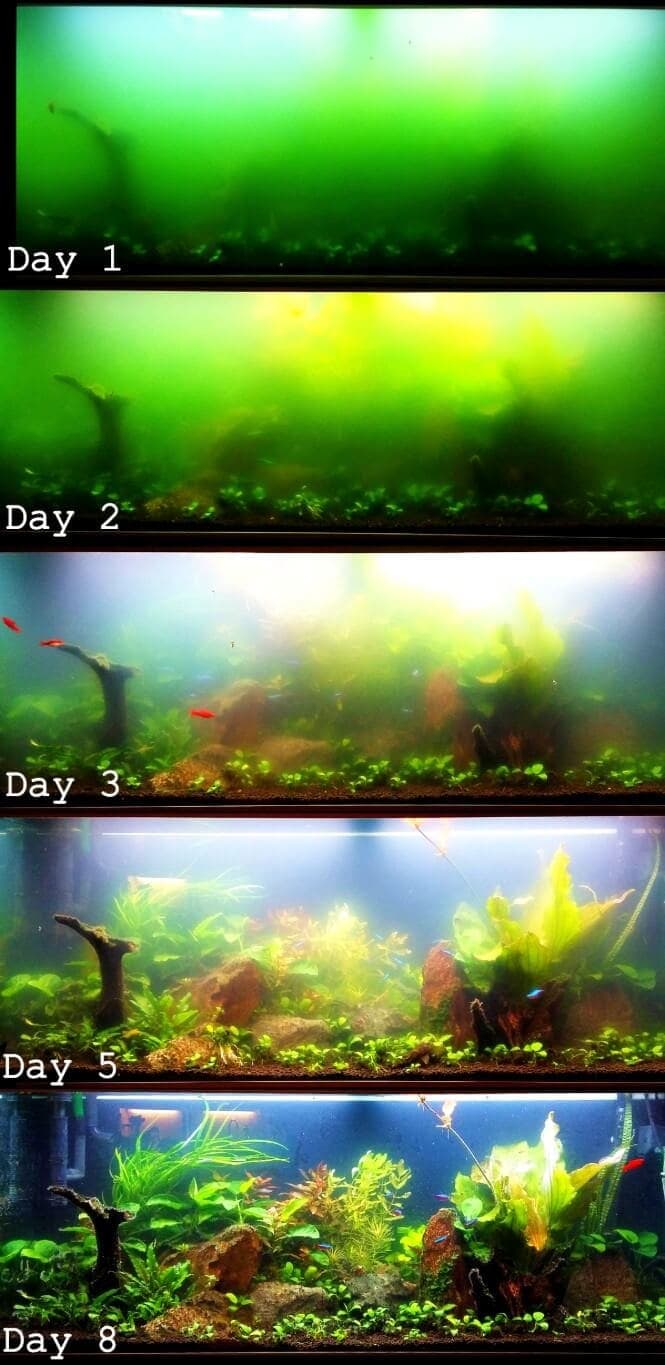
Here’s a real-life example of what the GKM can do in just a couple of days:
Anyway, the UV bulb chamber of the sterilizer is submersible.
The installation took me just about 5 minutes as advertised.
That’s apart from reading the instructions though.
There’s a part of the device that should not be hung over your aquarium water, so make sure you read them carefully.
It has its own pump, which eliminates complicated calculations of GPH for the best performance.
This is convenient because you only need to get one with the right bulb power and everything else takes care of itself.
Anyway, let’s talk about the work this UV sterilizer does.
The 9W version managed to clear the haziness of my tank’s water pretty fast (something like 40 hours or so). I used it for a bacterial bloom, which made the water pretty cloudy.
My tank was planted but by following a schedule, this UV sterilizer performed well, without interfering with the fertilizers.
I used the larger 24W version on my bigger tank for green water.
The story:
My 125-gallon tank was so densely populated with microscopic algae that I could barely see anything that was 3 inches further from the glass.
I was at my wit’s end so I decided to give this guy a try, after seeing its lighter version clearing the water in my smaller tank.
I went ahead and ordered it online.
From there everything changed.
In just about 3 days, if I remember correctly, the water in my large tank was back to normal.
Not even normal, actually. It looked pristine.
I run the units just as a precautionary measure.
I run them every 3 to 4 days for about 5 hours.
Haven’t had any outbreaks of bacteria, parasites, or micro-algae ever since.
I’m very happy with this brand. I sincerely think the AA Green Killing Machine is one of the, if not, the best UV sterilizer you could use for a home aquarium.
The 24W version can handle fish tanks of up to 180 gallons.
The 3W unit is ideal for smaller freshwater aquariums or nano reef tanks.
The low-Watt bulb power choices with the AA GKM is a fantastic thing when you have to deal with a nano tank that’s getting cloudy.
Other brands dedicated to this tank-size range, that I’ve seen are not well built and won’t last long. For this reason, I also consider the GKM one of the best and most adequate nano UV sterilizer choices for smaller aquariums.
No joke, the Green Killing Machines are worth every penny (in fact, I think they’re underpriced).
Drives me mad that I didn’t try them earlier.
Advantages:- Super-fast installation
- Has a built-in pump of its own
- Sturdy design
- Special UV bulb chamber for an extended dwell-time
- No work with external plumbing
- The suction cups don’t always hold well from the first time
- You can’t control the flow rate (the manufacturers claim that’s on purpose, and it does seem to work, so I’m somewhat fine with that)
2. Turbo-Twist UV Sterilizer – Best for Controlling Pathogens in the Aquarium
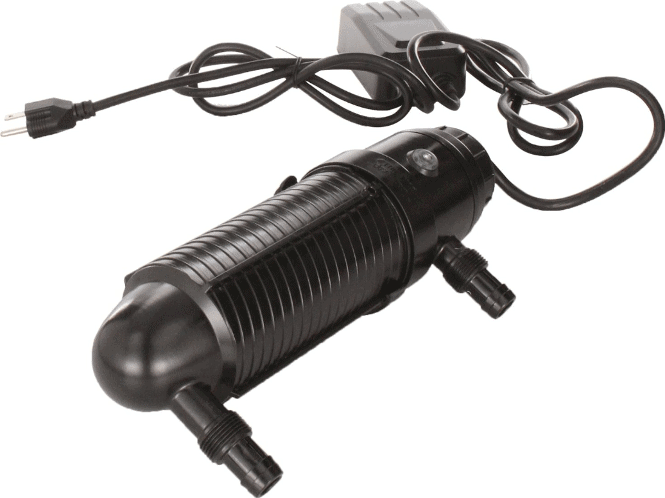
Click to compare pricing + see MORE photos of this product at:
The Coralife Turbo-Twist is my go-to UV sterilizer when my freshwater aquarium is having issues with external parasites or persistent bacterial blooms.
This is because the unit has a superior architecture to most UltraViolet aquarium sterilizers. The architecture allows for maximum dwell time (read the guide above if you don’t know what that is).
The “twist” of the water flow forces the water to spiral around the UV bulb more so than with other units on this list.
This in itself provides maximum exposure to the UV light which is more than enough to irradiate and neutralize persistent bacteria or pathogens such as the Ich parasite.
That being said, I’d only use Coralife’s X6 UV sterilizer model on fish tanks that hold no less than 55 US gallons of aquarium water.
The UV bulbs that come with these water sterilizers have immense power and do an excellent job of making the water in my aquariums crystal clear.
Don’t get me wrong, if you’re experiencing a simple bloom of algae that has turned the water in your fish tank green, this UV sterilizer will likely take care of the issue almost immediately.
From my experience, the X6 can clear up a severe algae bloom in a 55-gallon aquarium in less than 20 hours.
However, I’d strongly recommend this unit to aquarists who have issues with their tank getting constantly cloudy or has recently suffered from an Ich outbreak.
The strong UltraViolet bulb of this UV sterilizer will keep the parasites in the water in check, reducing their numbers to nearly zero.
This allows fish to build up their immunity and slime coat, and easily handle the few spores that are left on their own.
What I also like about this super-strong UV sterilizer is its compact size.
It is no larger than the Green Killing Machine (previous on this list), yet it harbors twice the power and potential to irradiate harmful pathogens.
The Turbo-Twist does not come with its own pump, but you can easily install it anywhere in your aquarium, and even hang it on the glass.
So, like any other product, this UV sterilizer is not an exception and does have its own issues.
I’m obviously obligated to mention those, as I’m trying my best to be as transparent as possible in my reviews.
Before getting my first Turbo-Twist UV water filter I obviously did some research on the product.
The most common complaint I found was that occasionally the sterilizer would leak.
Naturally, this is something that I would like to avoid in my aquariums.
However, knowing the nature of human error I decided to do some further digging.
What I noticed when I asked around was that almost everyone who complained of a leakage installed the unit with the bulb nest towards the floor.
I figured that the combination of gravity and improper handling or assembly could be contributing to the leaks.
I decided to order anyway and give the Turbo-Twist a try because I was having serious issues with a continuous bacterial bloom that I did not have the nerves to fight anymore…
When the unit arrived, I watched an online video on how to set it up properly and made sure to position the bulb nest pointing upwards.

Here’s what I mean:
I wouldn’t go as far as saying that this method of installation would absolutely solve any leak problems with this unit.
I will only say that I was personally involved in the purchase of 5 units (mine and my friend’s) and we did not experience any leak issues by doing the setup like this.
Anyway, the Turbo-Twist is an overall powerful UV sterilizer that can definitely clear up aquarium water from not only algae blooms but also persistent pathogens.
I would recommend it to anyone who owns a larger freshwater fish tank or has issues with continuously cloudy water and external parasites such as Ich and Velvet.
Advantages:- Does a fantastic job at keeping harmful pathogens and bacterial blooms in check
- “Twist flow” technology allows for maximum dwelling time and exposure of microorganisms to UltraViolet light
- Very strong UV bulbs
- Easy to install and can even be hanged on the back of the aquarium
- Does not take space inside the aquarium
- It’s compact
- May leak if not installed properly (but so will any other UV sterilizer)
- I would not use it in a marine aquarium, as it appears that saltwater makes it rust
3. AQUA UV Advantage 2000+ 15W – Durable & Sturdy
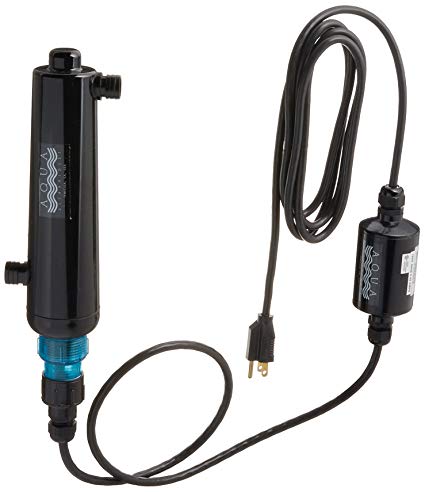
Click to see the current price + MORE photos on Amazon.
As the title goes, the AQUA Advantage Series are very durable and reliable units.
This external UV sterilizer, however, does not come with its own powerhead.
As much as I’m a fan of UV sterilizers that pump water on their own I’m pretty happy with this one’s performance so I included it in this list anyway.
It’s of high quality and it clears the water like a beast.
You can either plumb it in the return waterline of your reef tank’s sump or on the outtake of your freshwater fish tank’s canister filter.
The whole plumbing thing is not rocket science and, fortunately, it has been made so that everyone could assemble it on their own.
Moving on to the performance.
The higher Watt bulb allows for better sterilization, but that’s necessary since the unit is meant for larger aquariums where the flow rate is also higher. Still, the UV bulb is particularly durable and strong enough to handle aquariums of up to 125 gallons in volume. I’ve run this on a 90-gallon freshwater tank and it did an outstanding job at clearing the water.
The canister I was running on that system was a SunSun HW304B, which claims to turn the water for 520+ gallons per hour.
That, however, is not realistic (from my observations) and it actually turned around…350 GPH.
Which was still quite a lot, plus I ran 2 of these simultaneously.
Anyway, the Advantage 2000+ did its magic – the water got perfectly clear and no bacteria, algae, or parasite outbreaks were had ever since.
A “con” I would like to mention if I can call it this way, is that the hose of your filter may not always fit with the unit.
In that case, you’ll simply have to buy an adapter.
Hardware stores will have the fittings as they are pretty generic.
Just an extra walk to the store, that’s all.
Overall a very sturdy unit with huge potential. I like and recommend this UV sterilizer to fish keepers with above-medium-sized aquariums for the best performance.
Advantages:- Durable design is manufactured in the US
- UV bulb is one of the most durable ones I’ve personally seen
- Easy installation, despite being an external sterilizer (here, have this video for the setup)
- May need adapters to fit with your filter’s hose
- No powerhead, flow rate will depend on your filtration system
4. Jebao PU-36 UV sterilizer 36W – For Large Home systems & Outdoor Ponds
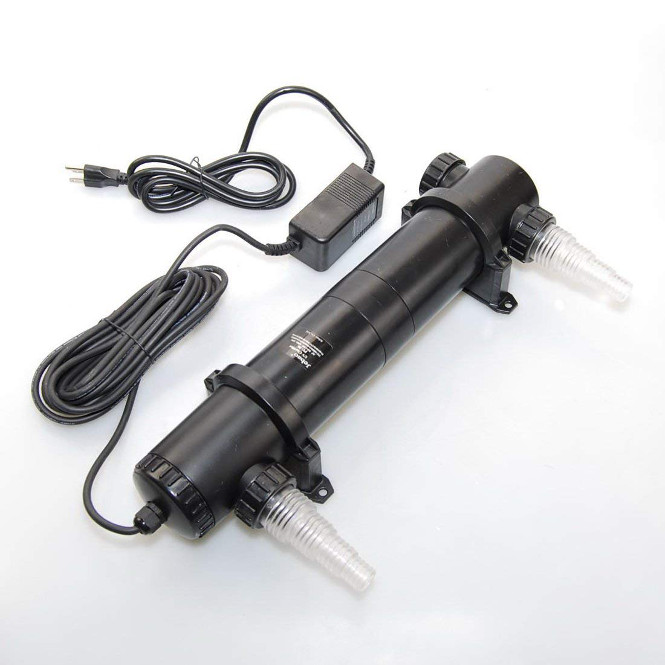
Click to compare pricing + see MORE photos of this product at:
If you have a pond of your own you are probably familiar with the Jebao equipment.
They make quality pond gear at very reasonable prices.
This 36W unit is the budget beast on this list.
It’s like the Hulk. It’s bulky and it destroys your aquarium’s enemies.
The Jebao PU-36 UV sterilizer is best used in very large aquariums of over 200 gallons or outdoor ponds. It’s designed to be weather-proof and it is not a submersible unit. It does not have its own powerhead, but that’s understandable, given that you’d likely need separate filtering systems for such-sized bodies of water.
There’s no need for any adapters, as it comes with variously-sized fittings for tubing.
The manufacturers claim that it will tolerate up to 4400 GPH.
The water inside of the chamber travels in a spiral around the UV bulb, maximizing dwell-time.
It’s actually very durable, despite its very competitive price tag.
I do not currently own an aquarium that’s 200+ gallons, but I have personally seen this device at work.
It can definitely handle heavily algae-infested ponds and aquariums spectacularly fast.
From seeing a couple of fish keepers using it, I can conclude that it clears roughly 100 gallons of water a day.
And by that I mean, it makes that volume of water crystal clear over that period.
If you have an exceptionally large aquarium or a decently sized backyard pond, then this should be your pick for healthy water conditions.
Mind that if you use it outside, you shouldn’t run it during the cold months.
The Jebao PU-36 is the best UV clarifier and sterilizer for large aquariums, in my opinion.
Definitely give it a chance to prove itself if you have one of those.
Advantages:- Best bang for your buck
- External – it does not interfere with your aquarium’s inner aesthetics
- Special bulb chamber design for maximum dwell-time
- Can handle extremely large volumes of water
- Durable build
- It’s bulky
- The instructions are outright garbage ( It’s really simple though, watch this guy’s video and you’ll get the hang of it)
5. COODIA 5W – Fantastic for Small Tanks
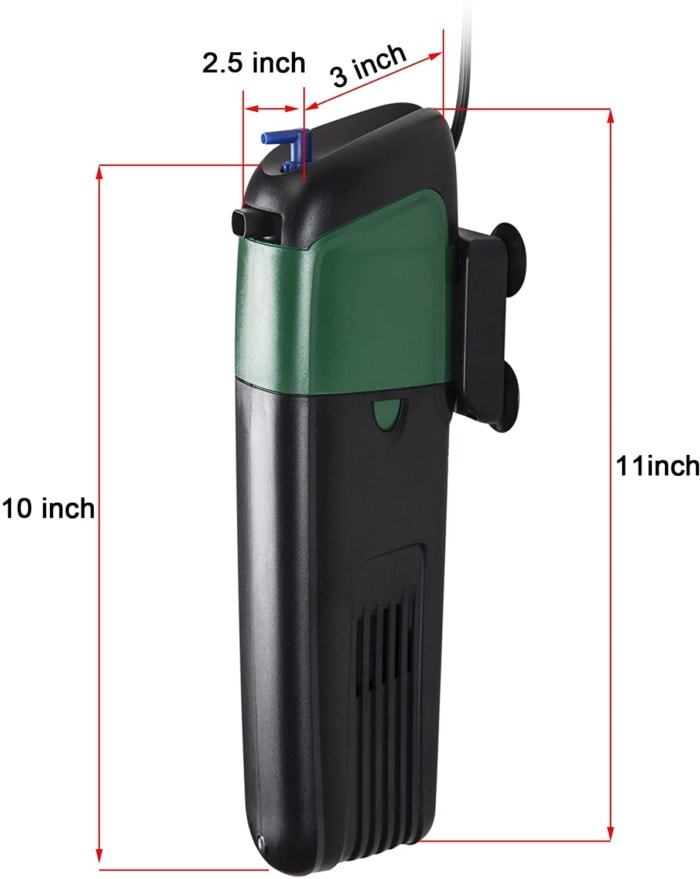
Click to see the current price + MORE photos on Amazon.
I will start this review by saying that the COODIA Internal UV sterilizer is a fantastic option for taking care of green water in smaller aquariums.
It has a 5-Watt light bulb and its own powerhead, which is optimal if you use it on the right tank size.
I’ve seen the COODIA work best in tanks that hold between 20 and 40 gallons of water.
For this reason, one thing I would not agree with is that it can clear the water in tanks that hold up to 75 gallons (as the manufacturers claim).
Obviously, I don’t agree with what its manufacturers claim – that it will clear the water in a 75-gallon aquarium.
Its powerhead is simply too weak to cycle such water quantities along the 5W bulb for the process to be efficient.
The maximum tank size for this UV sterilizer would be the 40-gallon tank in my opinion, and that’s still somewhat pushing it.
The main plus of COODIA is its competitive price. If you’re on a reeeeally tight budget but still have issues with green water in your tank – the COODIA might be for you.
However, don’t expect to rely on it for too long, even if used for maintenance.
I found the COODIA UV sterilizers to be less durable than the Green Killing Machine, for example.
Or at least that’s what I gathered during my research before I went ahead and bought this to test it myself.
Of course, there are some outliers that will last a good year or two with regular use, but at that price point that’s luck more than anything else, I think.
And before ome people point out that the price is adequate for the bulb’s power – the price with aquarium UV sterilizers is a reflection of their build’s quality moreso than the power of the bulb itself.
Anyway, I did manage to try the COODIA before it exploded in popularity, so I’d say my opinion on it is not influenced by its thousands of positive reviews online.
I followed the somewhat “broken” English in the instructions, installed it and it took this UV sterilizer roughly 6 days to clarify the water in the test aquarium (30-gallon tank).
In the following 5 months, the unit managed to keep the tank’s water clear at all times.
All in all, my opinion is that the COODIA Internal UV sterilizer is a decent budget choice for clearing the water in smaller tanks and should not be overlooked.
Advantages:
- Great price
- Works pretty much as advertised
- Has its own powerhead
- Not as durable as the other brands on this list
- The instructions can be confussing because of sloppy translation
What size UV sterilizer to choose for your fish tanks?
The above reviews are an overall evaluation of a certain unit. Let me give you some suggestions on where and how to use them. Here’s the best UV sterilizer in accordance with a fish tank’s gallon count:
1. Top UV sterilizers for 5-gallon fish tanks
For a 5-gallon tank, I wouldn’t recommend using a UV sterilizer unless you’ve already tried everything else. The reason is that these devices will take some room in such a small tank. In such a case, it is best to run one until it clears the water and then remove it. For this task you’d need something with no more than 3W of a UV bulb, that is submersible:
The perfect candidate for a 5-gallon aquarium is the clip-on UV water sterilizer, manufactured by AA Aquarium, which you can check at Chewy.com or Amazon. The AA Green Killing Machine has a low-Watt bulb that would be enough to rid any nano fish tank of cloudy water. It is submersible with its own pump and it works perfectly fine for small 5-gallon freshwater or saltwater tanks.
This magnificent little thing will definitely kill any free-floating algae spores and parasites that are populating your small nano tank.
It’s rated for up to 36 gallons per hour, so it may add slight turbulence to the tank’s water.
Note that if you have a Betta with large, beautiful fins it may experience some difficulties swimming around.
This may cause the fish to lay around more from exhaustion, which is normal behavior when facing a stronger current.
For this reason, I recommend that you use this sterilizing unit only when needed and not all the time.
You won’t regret it, just mind the time it is running.
I would not keep it on for more than 12 hours a day.
2. Top UV sterilizers for 10-gallon fish tanks
In a 10 gallon aquarium it is really best to have a UV sterilizer that has its own powerhead:
For an aquarium that has 10 gallons of water volume, having 3W of UV bulb power would be more than enough, given the flow rate of the device is decent. The best unit, in that case, would be the clip-on Green Killing Machine (check it out at Chewy.com and Amazon.com). It’s an internal, submersible UV sterilizing system that will do its job as it’s rated for up to 20 gallons.
The water turnover of the pump is ideal for clearing up such volumes of water (around 37 gallons per hour).
The product is about 7 inches in length and roughly 2.5 inches in diameter so it fits a 10-gallon fish tank nicely.
3. Top UV sterilizers for 20-gallon fish tanks
To be honest the above recommendation ( AA Green Killing Machine, 3 Watt bulb ) would be sufficient for a 20-gallon fish tank as well:
The AA Green Killing Machine UltraViolet sterilizing device fits in the 20-gallon aquarium range upon manufacturer guidelines, because it has a 3 Watt bulb. You don’t need a unit with a more powerful bulb for this kind of setup. If it’s not your only water turnover unit it will do a fantastic job at eradicating the harmful pathogens and microalgal blooms in your fish tank’s water.
From what I’ve seen with clients, you should be set, with crystal clear water in less than 2 days, or in some heavy “green water” cases – 3 days.
4. Top UV sterilizers for 30 and 40-gallon fish tanks
If you have either 30 or 40 gallons of a fish tank (or a pond for that matter) you’d want a sterilizer with roughly 5 to 7 Watts of bulb power. For these two particular cases I’ve seen a fantastic result with a 5W UV bulb:
The device I used on my 40 gallons was this one (link will show you some photos on Amazon). It has 5 Watts of bulb power and its own pump, which is ideal for any fish tank in the volume range of 30 and 40 gallons.
It thoroughly cleared up my water that had turned into a pea-soup color in just about 6 days.
From dense green where I couldn’t see the other side of the tank to super clear and transparent.
From then on I occasionally ran the sterilizer every 3 to 4 days for about 4 hours, which seemed to provide enough UV sterilization.
I used it in a freshwater setup but I’m not sure whether you could use the Coralife Mini sterilizers for nano reef aquariums of up to 40-gallons as well. You can also read more user reviews about this product on Amazon by clicking here.
5. Top UV sterilizers for 55-gallon fish tanks
To best clear up 55 gallons of green aquarium water you’d need a UV sterilizer with a light bulb of between 7 and 10 Watts:
The GKM UV sterilizer may work best for medium-sized fish tanks. It has a 9 Watts UV lamp that will completely filter and clear up the water in a 55-gallon aquarium in about 3 days. This water sterilizer works for both freshwater and saltwater reef tanks alike.
Click here to see the 9-Watt GKM UV sterilizer at Chewy or visit this page to check it out on Amazon.
It’s currently dominating the market and for a reason.
Frankly, the 9 Watt version is among the best budget-friendly yet super productive aquarium sterilizing units.
Though it’s rated for up to 50 gallons, it will do an outstanding job in a 55-gallon aquarium.
It shows noticeable results fast and you don’t need to run it 24/7 when using it as a preventive measure.
I am a huge fan of these units, and I personally own 2 of them (one 9W and one 24W for a larger tank I have).
It’s reasonably priced for the job done, so I would say it’s absolutely worth it.
By the way, going through some reviews, you may find that many users say that you shouldn’t purchase the 9W version unless your tank is 40 gallons or less.
My experience, along with my crystal clear water on the 55-gallon I have has proven otherwise.
It will do the job, so no need to pay extra cash for a stronger unit.
However, if you’re experiencing something more than just green aquarium water you may want to get something with a stronger UV bulb.
For controlling parasitic outbreaks and cloudy aquarium water that keeps coming back, I’d recommend getting the Coralife Turbo-Twist X6 UV Sterilizer (see it here on Chewy.com and here on Amazon.com).
It has twice the irradiating power of the green Killing Machine, which is what I would use to manage nasty pathogens in a 55-gallon fish tank.
In my experience, it will efficiently reduce the harmful microorganism colonies that inhabit the aquarium and eliminate any anxiety that you may have over external parasites.
Make sure to read the review that I shared earlier in this article for more information on the unit.
6. Top UV sterilizers for 75-gallon fish tanks
If you want to clear up green water in your 75-gallon fish tank in a matter of days you’re looking into getting a UV sterilizer with a 13 to 15 Watts bulb. A good recommendation I can give here is this AQUA UV Advantage 2000+. The Advantage 2000+ packs enough bulb power to show the best performance in a 75-gallon aquarium with a severe algae bloom.
So as the title goes, you’ll clear 75 gallons of aquarium water with this unit in a matter of days.
I have personally witnessed this UV sterilizer take care of a can’t-see-through algae soup in just about 3 days.
On the fourth day, the water was still partially cloudy, but not green by any means. At the beginning of the 5th day, it was completely clear, as if fish were levitating in the air.
Anyway, you’ve probably already noticed the price tag.
The AQUA UV Advantage is of high quality and the price is justified, as you could see in my review of it above.
Since this unit has a controllable flow rate, I’d suggest keeping it at the lowest possible setting, after initially clearing your water.
Anyway, if you are like me you’re likely paranoid about parasitic outbreaks that could crash your whole aquarium system in days.
If that’s the case, I can recommend getting a UV sterilizer with a more powerful light bulb.
For a 75-gallon fish tank I would recommend going with a UV water filter that has at least 18 Watts of UltraViolet bulb power.
This way you’ll keep parasites and harmful pathogens in check.
A good recommendation that won’t break the bank would be the 18-Watt UV sterilizer made by Coralife. For your convenience – here’s a link to check this UV sterilizer on Chewy.com and another one to see the device on Amazon.com.
On top of having the needed irradiation strength, the unit has a special “twist flow” build which maximizes the dwell time of microorganisms under the bulb.
By running this powerful UV sterilizer on your 75-gallon fish tank, you won’t experience cloudy water that keeps coming back or parasitic outbreaks that could wipe out the entire fish population in the tank.
Note that you should not run the Coralife X6 every single day.
This way you’ll prolong the lifetime of the bulb.
Turn the sterilizer on every 3 days or so for a couple of hours. My success has been with keeping it on for about 4 hours a day.
7. Top UV sterilizers for 90-gallon fish tanks
For clearing up the water in your 90-gallon fish tank you’d need between 15 and 18W of a UV bulb. Scaling the Wattage is important because the bigger the aquarium, the more flow is needed to maintain its full capacity under protection from harmful organisms.
The higher the flow rate, the more UV power you want, because the dwell time (time in which the microorganisms are exposed to the UV light in the tube) gets reduced.
In this case, a 15 to 18 Watts bulb compensates with its raw power for the naturally higher flow rate in larger aquariums.
A reliable UV sterilizer that has the right flow + Wattage for clearing up the green tint of water in a 90-gallon aquarium would be the Turbo Twist UV water filter X6 (link to Chewy and link to Amazon for photos and pricing comparison).
The Coralife Turbo-Twist X6 is a beast in the industry, that along with being really efficient comes with extra durability (for some reason).
I say “for some reason”, because, at first, it looks cheaply built, but you can actually use it for years to come, provided you interchange bulbs when needed.
It has a slightly higher price on it, though I can confirm that’s justified.
This particular aquarium UV sterilizer can be used for freshwater fish tanks that are up to 125 gallons with great success.
This one, unlike the Green Killing Machine ones I recommended so far, does not have its own powerhead, so make sure that you plumb it in your filter or pump’s outtake.
The mounting is easy, just follow the manufacturer’s instructions.
An absolute beast, that I actually own and am pretty happy with.
Anyway, If you own a reef tank you should likely get the AQUA Ultraviolet Advantage 2000+ as it handles saltwater better than Coralife’s X6.
Plug the Advantage 2000+ UV sterilizer right after any form of filtration in your sump.
This way the UV light will be more efficient and it won’t interfere with, say, the nutrients needed in your reef’s refugium.
For controlling pathogens in a 90-gallon freshwater fish tank, I recommend doubling the Watt power of the UV lamp.
You can get away with the Turbo Twist X12 (Chewy and Amazon both offer it), which has a bulb power of 36 Watts.
A UV sterilizer of this bracket will easily keep the free-floating pathogens in a 90-gallon aquarium under control.
Get the X12 if you’re struggling with parasitic outbreaks such as Ich, or persistent fogginess of the aquarium water caused by massive bacterial blooms.
8. Top UV sterilizers for 125-gallon fish tanks
Sterilizing 125 gallons of water is not an easy task unless you buy the right equipment. Here’s what I’ve found works for me:
You could absolutely use my previous recommendation here. Though it’s a smaller Wattage, this UV sterilizer’s design and size are made to serve large aquariums such as the 125-gallon one.
It will successfully solve your green water problem while getting you rid of harmful organisms in the longer run.
However, it’s not what I run on MY 125 gallon.
On my tank, I run this (visit the link to see it on Chewy.com or CLICK!… to see it on Amazon).
Reason is that I was super happy with the 9 W version. This larger unit, despite being 24W is rated for up to 120-gallon fish tanks.
Anyway, I really wanted to try the scaled version, so I asked around and it turns out many were using it not only on their 125s but also on up to 180-gallon aquariums.
So I went ahead and purchased the thing because I wanted to keep my Coralife Turbo-Twist x6 for my other smaller tank with fish.
Oh, boy, am I glad that I did.
This UV sterilizer (the GKM) worked perfectly, made my aquarium’s water crystal clear, and I’ve never had a “crashed” 125-gallon tank after getting it.
Turns out it’s a low-cost alternative to other, more expensive brands, and it actually does the job.
It has its own pump, making it way easier to install and you don’t really have to calculate flow rates. Simply enjoy the healthy water.
I’m a die-hard fan of this device and would recommend it to anyone in doubt (which happens often, because of people being skeptical towards the magic power of the UltraViolet spectrum).
Anyway, to keep harmful aquatic pathogens at bay in your freshwater aquarium you’ll likely need a UV sterilizer that has at least 30 W of UV bulb power.
A good recommendation I keep making for one such unit is the Turbo-Twist X12 UV Sterilizer and you can get it at both Chewy and Amazon.
It’s a rather compact unit that packs a serious punch of UV and extended dwell time, enough to neutralize most free-floating parasites and uninvited bacteria in a 125-gallon fish tank.
Make sure to read its review at the beginning of this article if you’re after pathogen control in your aquarium.
Let’s summarize:
If you want to have a disease-free large aquarium and keep your expensive fish healthy for the rest of their days, buy a 36 Watt Coralife Turbo-Twist X12 Ultraviolet Sterilizer and call it a year.
If you have a reef tank, get a Jebao PU-36 as an alternative because it also has a 36-Watt bulb, but is more resistant to salty water than the Turbo Twist.
If you want to quickly clean up any green water in a 125-gallon aquarium, get the Green Killing Machine with the 24W bulb.
On a side note, I’ve seen the 24W UV sterilizer work for cloudy reef tanks of over 100 gallons.
I’ve personally used both units in freshwater systems.
They’re probably the best units for this aquarium size range.
9. Top UV sterilizers for 150-gallon tanks
A UV sterilizer that will best fit and clear the water of a 150-gallon tank would be the GKM24W. This is it on Chewy.com and this is its page on Amazon for pricing info and more photos of the unit.
As I mentioned in the above section (I suggest you read that if you just jumped straight to here) the GKM UltraViolet water sterilizer will perform fantastically for this range of water volume.
The UltraViolet bulb is as durable as it gets and you should probably run it on a timer after killing off the initial microalgae bloom in your 150-gallon tank.
I run mine that way, and I don’t keep it on for more than 5 hours as a precaution for algae blooms.
The pump comes with a 3-year warranty and the bulb should be changed every 6 months.
That’s according to the manufacturers, with a daily usage implied.
I’d like to think it’s smart of me to run it every couple of days instead. This way I make sure to prolong the bulb’s life for about a year or so.
It’s been almost a year since I last changed mine and it’s still running like a beast, no bulbs replaced yet.
An overall great product, in my opinion. I can totally vouch for this UV water sterilizer serving your 150-gallon fish tank well when it comes to green aquarium water.
For a 150-gallon aquarium that experiences frequent parasite outbreaks, however, I would recommend the 36 Watt Coralife X12 which you can find at either Chewy.com or Amazon.
It’s a great unit for pathogenic control in large aquariums of this or similar volume capacity.
It does not have its own pump, so you just connect it to your filter.
The 36 Watt bulb is very effective, even with the strong GPH rates of larger aquarium filters.
The “twist flow” technology maximizes the dwell time of aquatic parasites and bacteria under UV light.
My experience has been that a UV sterilizer of this size works best for pathogen control in this kind of aquarium system.
10. Top UV sterilizers for 180-gallon tanks
To clear the green from the water in your 180-gallon aquarium you’d need between 24 and 30W UltraViolet sterilizer:
In that case, the aforementioned recommendation will do.
The Green Killing Machine 24W is powerful enough to clear the water of 180-gallon fish tank in just about 4 days.
The Coralife Turbo-Twist X12, however, will be powerful enough to keep your water free from parasitic outbreaks and persistent bacterial blooms (see this unit at Chewy and also Amazon).
Choose depending on your goal.
The size of the UV sterilizer is not of importance here, but rather the power of the UV light combined with the time of exposure.
Install your unit of choice and wait out for a couple of days. After the water gets crystal clear all the microalgae or blooming bacteria will be dead.
You’d want to occasionally run either every couple of days, to ensure a dwell time to which parasites or free-floating algae (depending on your choice of UV) are exposed to the ultraviolet spectrum.
This way you’ll be able to keep your fish tank or pond’s water vermin-free.
The effectiveness of these UV sterilizers makes them especially useful in very large fish tanks with expensive gear and fish.
Seeing how efficient both of these units are over my own fish tanks, and also in the hands of my clients (owners of 180-gallon fish tanks or ponds), you can rest assured that they are worth every penny.
And given how high the pricing on UV sterilizers can get, that’s not a lot of pennies, while still getting the work done.
I recommend trying either according to your goal.
11. Top UV sterilizers for 200-gallon or larger fish tanks
For a 200-gallon fish tank we’d need to scale up the wattage:
Honestly, the 24 Watt Green Killing Machine from the previous recommendation might work for clearing your “pea soup”. However, this will likely take a long time and the bulb won’t be strong enough to protect your 200-gallon aquarium from pathogenic outbreaks.
If my calculations are right, using the Green Killing Machine’s 24 Watt light bulb would take around a week to destroy any traces of microalgae, which is okay.
If that’s your end goal – order it here on Chewy or here on Amazon and be done with it (visit the link to see more details on Chewy).
However, if you’d like to be able to protect your large home aquarium or outdoor pond from future outbreaks of parasites, you’d want a stronger bulb.
I can suggest something that I’ve seen work for aquariums and ponds that were over 200 gallons, actually:
It’s a Coralife with 36 Watts of ultraviolet sterilization. It clears roughly 100 gallons of aquarium or pond water in a day. It’s a non-submersible external UV sterilizer.
I’ve witnessed this monstrous UV clear the green water in a 200-gallon fish tank in 2 days.
It’s an external UV sterilizer, not submersible. Do not submerge it underwater, and as the manufacturers suggest, install it after the outtake of your pump/canister filter.
That’s a good tip for any water sterilizer out there, as this way they’re only targeting microorganisms and not gunk or debris.
Take a look at the 36-Watt Coralife UV sterilizer at Chewy’s online store here (or click here to see it on Amazon).
Be it a 200, 300, or even 500-gallon tank, this unit will do its job, without breaking the bank.
I am kind of against hundreds of dollars worth of aquarium equipment, especially in this field (water disinfection).
Most “cheaper” units will absolutely do the job and this device is the perfect example of that.
Note that if your budget is really tight you could go for a Jebao PU-36 here which you can find at both Chewy and Amazon.
It’s a rather inexpensive UV sterilizer that’s mainly used on ponds because it’s weatherproof.
Nevertheless, I’ve seen people use it successfully on large aquarium systems of 200 or more gallons as well.
I’ve also witnessed it make the water of a 700-gallon pond crystal clear in just about a week.
Some people report having cleared their ponds of over 9000 gallons with this unit. It’s that efficient.
Obviously, for pathogenic control in such a large aquarium, you could use the 55 Watt Jebao.
However, for an aquarium of this size I’d recommend something like this.
It packs a 55-Watt bulb.
From my research, it appears very durable and the price tag is acceptable.
I have not personally used this unit, but based on my experience with other UV sterilizers I’d say it’s a pretty solid choice for keeping the pathogens in a 200 to 300-gallon fish tank under control.
Tips for proper usage
To ensure optimal performance when using your UV sterilizer you should:
- Install it after your filter or pump’s outtake.
Aquarium water is densely populated by microscopic organisms, while high on other organic and non-organic matter. This means that some of the intruders you’d want to zap may ‘hide” behind the mass of other bacteria or debris. By installing the UV sterilizer right after the return line of your filtration system you are making sure that no debris will compromise the reach of the UV light.
- Use with filter floss for a crystal clarity.
Fine filter floss, such as quilt batting will make your water pristine on its own (look up my article on that in the Search bar). When combined with a UV sterilizer you will achieve a 100% transparent look, along with reduced chances of illness or an outbreak.
- Don’t use during nitrogen cycling.
Beneficial bacteria live on the surface area and not in the water column. When the tank is still cycling, however, the population will still be sensitive and therefore imbalanced. There’s a chance that you’ll reduce the numbers of other organisms that help the establishment of nitrifying bacteria. Only resort to a UV aquarium sterilizer if your fish tank experiences continuous bacterial bloom (7 days or more). After you turn off your UV unit, you can use bottled bacteria to ensure stability in the colonies of beneficial nitrifiers in your aquarium.
- Run it on a schedule.
To run a UV sterilizer 24/7 would be overkill unless otherwise stated by the manufacturer. A good disease-preventive schedule would be to run it every 3 to 4 days for no more than 5 hours.
- Turn it off while feeding your corals.
Since coral food is free-floating organisms, there’s a high chance that your UV sterilizer will decrease the value of the meal. Running it in a reef aquarium will never sterilize its water from beneficial phytoplankton, but you will have to add a little more food for your corals than usual. It’s well justified to spend a little more on food than hundreds of dollars for new fish every couple of months, because of a crash.
- Turn it off while dosing fertilizers to aquarium plants.
The UV light may alter the chemical structure of aquarium fertilizers, so you should not run it constantly when dealing with a high-tech heavily planted aquarium. If you follow my recommended schedule you will be completely fine.
- Clean the glass sleeve.
The glass sleeve is where the gunk of dead bacteria and other pathogens will accumulate. As with every other degrading matter, this may cause a spike in ammonia or nitrite if left for too long in the fish tank. Clean the glass sleeve every month or so if you’re running the UV sterilizer constantly.
- Never use it with medicine.
Most chemicals can also be broken down by high-energy ultraviolet photons. Running your UV sterilizer along with medicine in your tank is not a good idea. It may render the medicine useless or even worse, make it toxic.
- Change the bulb when the time comes. Otherwise, you’ll only waste electricity.
These are special UV bulbs that do wear off.
- Control the flow rate if possible.
A slower flow rate increases dwell time, ensuring damage to the more resilient parasites, bacteria, and fungi.
- Monitor the water temperature.
Logically, a strong UV-C lamp will give off some heat. These devices do raise the temperature in the aquarium, but that’s by a mere degree or two. The only time you should be concerned with that is during the extremely hot summer days, when some sort of cooling may be needed. My secret solution for this kind of situation is my air-conditioner.
FAQs
Do they actually work for clearing up aquarium water?
Not only do UV sterilizers work for clearing up aquarium, they are the best at it and do it the quickest. The mechanism of how they work is simple – the pump runs aquarium water through a tube, and the water gets irradiated by a powerful UV bulb. The UV light from the bulb damages and destroys algae spores and other harmful floating organisms.
What is the best one for a planted aquarium?
Whether your have plants in your aquarium or not is irrelevant to what UV sterilizer you should use in it. Just look for a UV sterilizer that has a sturdy build and a durable bulb. One thing to remember here is not to use UV light in an aquarium that has recently been fertilized. The UV light will break down chelated agents that bind metals in the fertilizer. This renders the metals more difficult to absorb by your aquatic plants.
What is the best one for a 75-gallon fish tank?
If you are trying to clear up a cloudy or green water in a 75-gallon tank, the best approach would be to use a UV sterilizer with a 13 or 15-Watt bulb. A UV light of that strength will completely clear up the water in the tank in just 4 to 7 days. If you’re trying to prevent or eliminate pathogens and parasites in the water you’d want to use a UV sterilizer with an 18-Watt bulb.
What is the best one for a betta fish and goldfish?
What type of fish you keep is not of importance when choosing a UV sterilizer for your aquarium. So there’s no “best one” for a Betta or a Goldfish. Your only concern when picking a UV water sterilizer should be the size and capacity of your fish tank.
A light conclusion
Choosing the best performer among the many UV sterilizers is actually quite simple, as long as you know your stuff. I hope that these reviews and additional guidance gave you the info you were looking for.
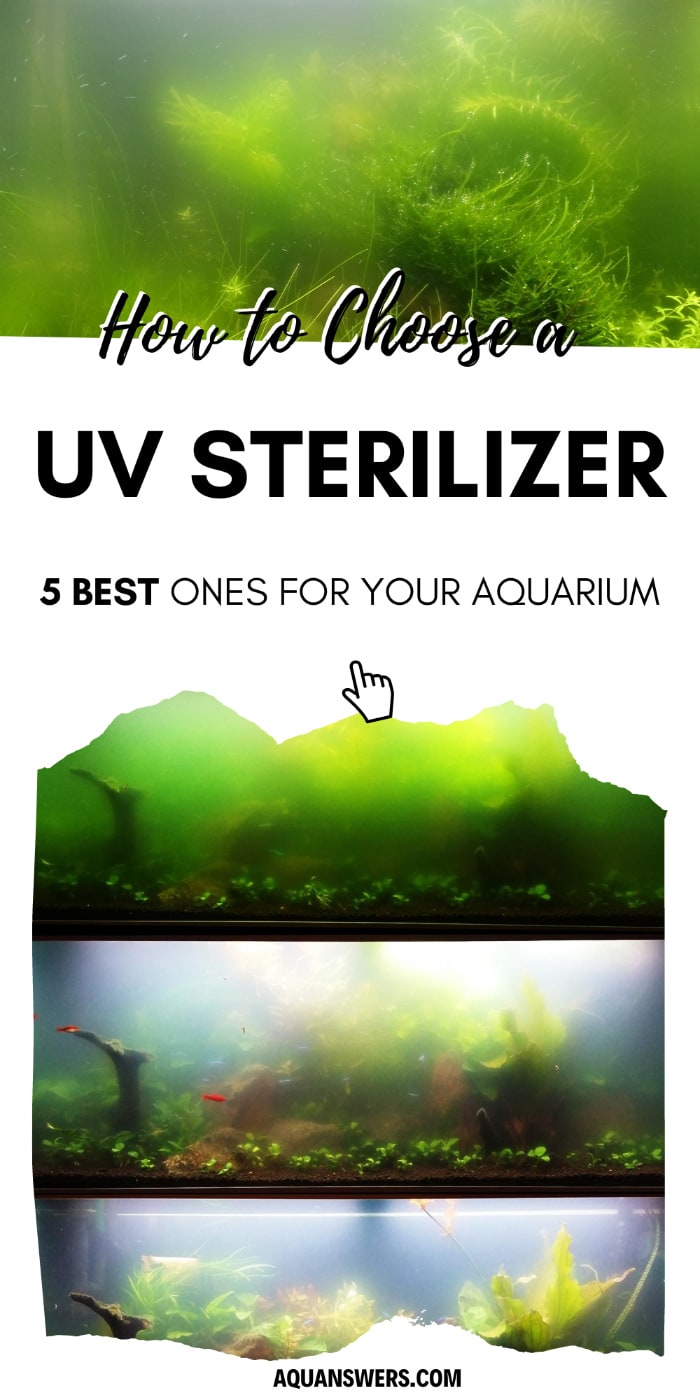
What model did you choose in the end? Is your setup freshwater or saltwater? Do you want an additional recommendation? Ask your questions in the comments and I will get back to you as soon as I see them.

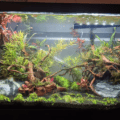

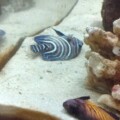
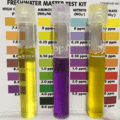





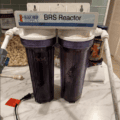
very clear and good article easy to understand. Thank you
All your AMZ links are dead.
Yeah, Amazon keeps randomly removing the Green Killing Machine from their listings.
So to actually help people I’ve also added links to Chewy.com where this UV sterilizer can be found at all times.
It’s truly one of the best ones out there, I’ve no idea why Amazon keeps doing that…
Hi Alvi.
I have a 75 gallon freshwater tank and want to know if any of the in tank sterilizer products would work for parasites as it looks like the in line products are preferred? I was specifically looking at the green killing machine with 24w but am open to any recommendations. If I had to look at in line products I am currently running two Fluval 4X canister filters but was hoping for the simplicity of the in tank product.
Thanks
Chris
Hello, Chris,
The 24 Watt version is an ideal solution for your setup.
Don’t hesitate to get it.
Momchil
Greetings. First of all, thank you for one of the most informative and detailed articles. I am fairly new to reefing and do not have a problem with algae blooms or green water in my 180-gallon Waterbox yet. My only purpose in wanting a UV Sterilizer at this point is to clear pathogens and parasites to avoid ich/diseases as best as I can. I notice that you clearly stated those features about the Corallife but I’m more interested in the AA Green Killing Machine (GKM) 24W, only because the ease of installation. Can I use the GKM and run it a longer period of time to serve my purpose? Thank you again!
Hi Alvi,
Good question.
In larger tanks, we use stronger UV bulbs because a stronger bulb can handle a higher flow rate and still remain efficient in killing off pathogens. It just makes it possible to “clear” the whole volume of aquarium water quicker.
A bulb with a lower Wattage just means it will take longer (given that you reduce the flow rate in the UV chamber enough for the bulb to be effective against parasites and bacteria).
All of this means that you can simply get 2x GKM 24W, position them on the opposite sides of the display reef tank, and have the same results as with one stronger UV unit (in terms of time and efficiency).
It also means that, yes, you may be able to use a weaker UV bulb and let it run for extended periods of time to serve your purpose, but I can’t guarantee that it will be super-efficient when it has to turn 180 gallons of water with a low-enough GPH to kill pathogens. It may be that the sheer unfiltered volume of water is enough to give time to certain pests the opportunity to bloom.
If it were MY 180-gallon reef tank and I had your concerns, I would just get 2 GKMs to play it safe (given that my budget was not an issue).
Makes sense, yes?
I hope this helps.
I really appreciate the prompt response! It makes sense and yes, I would rather purchase two of these units then one of the stronger, external units that you had endorsed, because lacking the proper skills, I would need to hire someone to assemble and neatly attach to my cabinet. One last question comes to mind. Could I get by with positioning two on the opposite ends of my 30-gallon sump instead of the display tank?
I get you.
However, I would say that placing them both in the sump would defeat the purpose of attacking pathogens “on two fronts” (too much water will be left unfiltered for a longer period of time, because of the low flow of the UV units). You could place one in the display tank (far from the sump’s intake) and one in the sump?
Again, thank you very much for the excellent article and for the personal advice!
I thank you, for being a reader! You guys make this possible (as I describe in my “About” page) 🙂
I really like your post because of it being full of information and useful. By the way, my family is using Turbo-Twist UV Sterilizer and I think it is working well. Thanks for your blog, I will keep reading your new posts.
Thanks, Wade!
I’m really glad you liked my post! It’s really motivational for me when someone tells me I helped them.
Also, thanks for confirming my experience with the Turbo-Twist UltraViolet Sterilizer!
Stay well.
Great information here, thank you so much.
Just wondering what size of pump should a guy get for the “Jebao with a 36 Watts”?
I would be using this in a hydroponic application, in my water storage tank before adding nutrients and feeding to my plants.
Thanks again for your help.
Hi, Jeratt,
The answer to your question greatly depends on the volume of water your storage tank will hold.
I’m assuming you’ve followed my recommendation from above, which means it will be more than 200 gallons, correct?
If it’s 200 to 300 gallons this pump is a great solution – link.
If it’s 400 to 800 gallons then you can definitely go with this one: link.
Makes sense?
Hope this helps!
Ok great, yes that does help. I think I even have a similar sized pump kicking around here.
Thanks for the help.
Even better – you’ll save some cash.
Glad my experience was of help!
Hello what if i use more watts for lower gallons will this do the job quicker? Is there any side effects on that? Ofc will have it few hours per day.
Hi Kostas,
More Watts will definitely speed up the process!
Good luck!